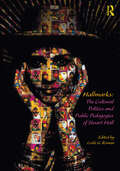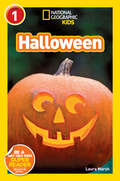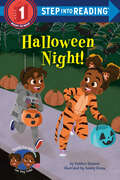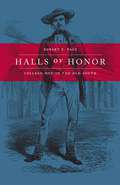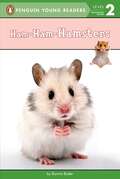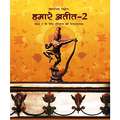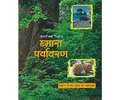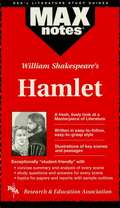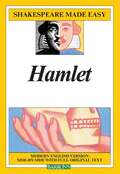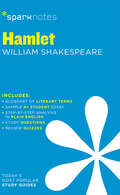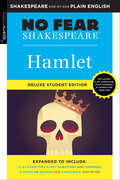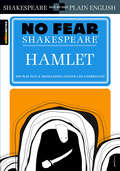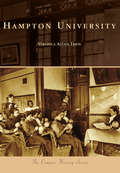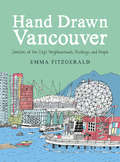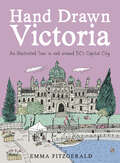- Table View
- List View
Hallmarks: The Cultural Politics and Public Pedagogies of Stuart Hall
by Leslie G. RomanThis provocative, interdisciplinary, and transnational collection delves deeply into the educational and public intellectual hallmarks of Stuart M. Hall, a core figure in the development of the post-War British New Left, of Cultural Studies at the Centre for Contemporary Cultural Studies and later, of the Open University. It opens new vistas on both critical educational studies and cultural studies through interviews with, and essays by, leading writers, shedding light on the under-appreciated public pedagogical and cultural politics of the New Left, of Thatcherism, and of Rightist, neo-colonial, diasporic, and neo-liberal formations in Jamaica, the UK, Australia, North America, and Brazil. Intimate and moving, the contributors describe Hall’s diasporic formation as a courageous ‘artist’ and educator of cultural politics and social movements, showing both the reach and the relevance of his public pedagogies in the construction of alternatives to essentialist racial politics and the despairing cynicism of neo-liberalism. With contributors and interviewees including Leslie G. Roman, Michael W. Apple, Avtar Brah, John Clarke, Annette Henry, Lawrence Grossberg, Luis Gandin, and Fazal Rizvi, Hallmarks: The Cultural Politics and Public Pedagogies of Stuart Hall reveals that neither cultural politics nor public pedagogies are stable or self-evident constructs. Each legitimates and requires the other as part of a longer radical democratic project for social justice. This book was originally published as a special issue of Discourse: Studies in the Cultural Politics of Education.
Halloween (National Geographic Kids Readers)
by Laura MarshFrom visiting the pumpkin patch, to bobbing for apples, to picking out a favorite costume, Halloween is a magical time for young children. The fun and festivities are captured in this book, with full-color illustrations and simple easy-to-grasp text. In the spirit of this beloved holiday, this level one reader is sure to captivate and fascinate children. This high-interest, educationally vetted series of beginning readers features the magnificent images of National Geographic, accompanied by texts written by experienced, skilled children's book authors. The inside back cover of the paperback edition is an interactive feature based upon the book. Level 1 books reinforce the content of the book with a kinesthetic learning activity. In Level 2 books readers complete a Cloze letter, or fun fill-in, with vocabulary words.Releases simultaneously in Reinforced Library Binding: 978-1-4263-1035-5 , $13.90/$15.95 CanNational Geographic supports K-12 educators with ELA Common Core Resources.Visit www.natgeoed.org/commoncore for more information.
Halloween Night! (Step into Reading)
by Candice RansomBOO! Get ready for some Halloween excitement with the Day family! Join Brother and Sister on their trick-or-treating adventure in this Step 1 reader, perfect for children who know their alphabet and are eager to learn how to read!Brother and Sister can't wait to go trick-or-treating! They put on their costumes and hurry out into their festive neighborhood. The night is filled with so much fun: candy, costumes, a parade, and some silly scares! At last, Brother and sister are so excited to get home and sort their candy! Halloween night is so very special and the Day kids cannot wait till next year!Step 1 Readers feature big type and easy words to decode. They are for children who know the alphabet and are eager to begin reading aided by rhymes and rhythmic text paired with picture clues. A day with family is always a great day! Read all the Day kids books, including:Apple Picking Day!Pumpkin Day!Beach Day!Snow Day!and more
Halls of Honor: College Men in the Old South
by Robert F. PaceA powerful confluence of youthful energies and entrenched codes of honor enlivens Robert F. Pace's look at the world of male student college life in the antebellum South. Through extensive research into records, letters, and diaries of students and faculty from more than twenty institutions, Pace creates a vivid portrait of adolescent rebelliousness struggling with the ethic to cultivate a public face of industry, respect, and honesty. These future leaders confronted authority figures, made friends, studied, courted, frolicked, drank, gambled, cheated, and dueled -- all within the established traditions of their southern culture.For the sons of southern gentry, college life presented a variety of challenges, including engaging with northern professors and adjusting to living away from home and family. The young men extended the usual view of higher education as a bridge between childhood and adulthood, innovatively creating their own world of honor that prepared them for living in the larger southern society. Failure to obtain a good education was a grievous breach of honor for them, and Pace skillfully weaves together stories of student antics, trials, and triumphs within the broader male ethos of the Old South. When the Civil War erupted, many students left campus to become soldiers, defend their families, and preserve a way of life. By war's end, the code of honor had waned, changing the culture of southern colleges and universities forever.Halls of Honor represents a significant update of E. Merton Coulter's 1928 classic work, College Life in the Old South, which focused on the University of Georgia. Pace's lively study will widen the discussion of antebellum southern college life for decades to come.
Halo (Halo Trilogy #1)
by Alexandra AdornettoWhen three angels are sent from heaven to protect the town of Venus Cove against the gathering forces of darkness, their mission is threatened as the youngest angel, Bethany, enrolls in high school and falls in love with another student.
Ham Radio License Manual
by American Radio Relay LeagueHam Radio License Manual is a book that targets the interests of the Amateur Radio at all levels. Amateur radio is based on first hand information; direct communication to the people without any use of an intermediary like government communication systems. Amateur radio or hams are known for their effective innovative characteristics. The book starts by giving a brief history of the Amateur radio and hams. Don't miss on How To Use This Book before the chapters begin.
Ham-Ham-Hamsters (Penguin Young Readers, Level 2)
by Bonnie BaderLearn all about hamsters in this fact-and-photo-filled book for young readers!Their tiny feet scamper across cages and sprint on exercise wheels. Their little noses sniff the air and their whiskers twitch as they stuff their cheeks with food. As some of the most adorable members of the rodent family, hamsters make very popular pets. Especially in the classroom! In this nonfiction reader, kids will learn all about how to care for these cute critters.
Hamara Atit 2 class 7 - NCERT: हमारे अतीत 2 कक्षा 7 - एनसीईआरटी
by Rashtriy Shaikshik Anusandhan Aur Prashikshan Parishadहमारे अतीत-2 कक्षा 7 के लिए इतिहास की पाठ्यपुस्तक, एन.सी.ई.आर.टी. इस पुस्तक की रचना के लिए बनाई गई पाठ्यपुस्तक निर्माण समिति के परिश्रम के लिए कृतज्ञता व्यक्त करती है। इस पुस्तक के प्रत्येक अध्याय को कई भागों में बाँटा गया है। इन भागों को पढ़ने, इस पर आपस में बातचीत करने और समझने के बाद ही अगले अध्याय की शुरुआत कीजिए।
Hamara Paryavaran
by National Council Of Educational Research TrainingThis book prescribed by central board of secondary education, India for the students of class 7th subject Social Science, studying through hindi medium. This accessible version of the book doesn’t leave any part of the book. The book is handy companion of the school and university students desiring to read facts in interesting way. NCERT books are must read for aspirants of competitive and job related examinations in India.
Hamara Paryavaran Bhugol class 7 - NCERT: हमारा पर्यावरण भूगोल कक्षा 7 - एनसीईआरटी
by Rashtriy Shaikshik Anusandhan Aur Prashikshan Parishadहमारा पर्यावरण कक्षा 7 के लिए भूगोल की पाठ्यपुस्तक - राष्ट्रीय शैक्षिक अनुसंधान तथा प्रशिक्षण परिषद्, इस पुस्तक के विकास में सहयोग देने हेतु दौलत पटेल, अध्यापिका (अवकाशप्राप्त), सरदार पटेल विद्यालय, नयी दिल्ली; स्वागता बासु, लेक्चरर, एस.एस.वी. (पी.जी.) कॉलेज, हापुड़ एवं शिप्रा नॉयर, दार्जिलिंग का आभार व्यक्त करती है। निम्नलिखित बिंदु इस पाठ्यपुस्तक में इस्तेमाल किए गए भारत के मानचित्रों के लिए लागू हैं- भारत सरकार का प्रतिलिप्याधिकार, 2006, आन्तरिक विवरणों को सही दर्शाने का दायित्व प्रकाशक का है, समुद्र में भारत का जलप्रदेश, उपयुक्त आधार-रेखा से मापे गये बारह समुद्री मील की दूरी तक है, चण्डीगढ़, पंजाब और हरियाणा के प्रशासी मुख्यालय चण्डीगढ़ में है।
Hamare Ateet - III
by NcertThis book is prescribed for the student of class 8. This book is about the history of Modern India and India’s struggle for independence.
Hamare Ateet - III
by NcertThis book is prescribed for the student of class 8. This book is about the history of Modern India and India’s struggle for independence.
Hamare Ateet - III bhag 1
by National Council Of Educational Research TrainingThis book prescribed by central board of secondary education, India for the students of class 8th subject Social Science, studying through hindi medium. This accessible version of the book doesn’t leave any part of the book. The book is handy companion of the school and university students desiring to read facts in interesting way. NCERT books are must read for aspirants of competitive and job related examinations in India.
Hamare Ateet - III bhag 2
by National Council Of Educational Research TrainingThis book prescribed by central board of secondary education, India for the students of class 8th subject Social Science, studying through hindi medium. This accessible version of the book doesn’t leave any part of the book. The book is handy companion of the school and university students desiring to read facts in interesting way. NCERT books are must read for aspirants of competitive and job related examinations in India.
Hamare Ateet-1
by National Council Of Educational Research TrainingThis book prescribed by central board of secondary education, India for the students of class 6th subject Social Science, studying through hindi medium. This accessible version of the book doesn't leave any part of the book. The book is handy companion of the school and university students desiring to read facts in interesting way. NCERT books are must read for aspirants of competitive and job related examinations in India.
Hamlet (MAXNotes Literature Guides)
by Joanne MillerREA's MAXnotes for William Shakespeare's Hamlet The MAXnotes offers a comprehensive summary and analysis of Hamlet and a biography of William Shakespeare. Places the events of the play in historical context and discusses each act in detail. Includes study questions and answers along with topics for papers and sample outlines.
Hamlet (Shakespeare Made Easy)
by William ShakespeareHere are the books that help teach Shakespeare plays without the teacher constantly needing to explain and define Elizabethan terms, slang, and other ways of expression that are different from our own. Each play is presented with Shakespeare's original lines on each left-hand page, and a modern, easy-to-understand "translation" on the facing right-hand page. All dramas are complete, with every original Shakespearian line, and a full-length modern rendition of the text. These invaluable teaching-study guides also include: Helpful background information that puts each play in its historical perspective. Discussion questions that teachers can use to spark student class participation, and which students can use as springboards for their own themes and term papers. Fact quizzes, sample examinations, and other features that improve student comprehension of what each play is about.
Hamlet (Short, Sharp Shakespeare Stories #30)
by Anna ClaybourneTo be or not to be? That is the question...A murdered king, his haunted son, a wicked stepfather and a doomed romance... Listen on, through madness and mystery, to discover the calamitous tale at the heart of Hamlet, one of Shakespeare's most famous tragedies.As well as the story, this audiobook contains information about the background to Hamlet, its major themes, language, and Shakespeare's life during the time he was writing the play. Madness, and how it was treated in 16th century England, is also examined, to give some context in which the play was written.The Short, Sharp Shakespeare series consists of six books that retell Shakespeare's most famous plays in modern English. Fun sound effects and atmospheric music accompany each narration, making them a great introduction to "the Bard" for children .(P) 2023 Hodder & Stoughton Limited
Hamlet SparkNotes Literature Guide (SparkNotes Literature Guide Series #31)
by SparkNotesHamlet SparkNotes Literature Guide by William Shakespeare Making the reading experience fun! When a paper is due, and dreaded exams loom, here's the lit-crit help students need to succeed! SparkNotes Literature Guides make studying smarter, better, and faster. They provide chapter-by-chapter analysis; explanations of key themes, motifs, and symbols; a review quiz; and essay topics. Lively and accessible, SparkNotes is perfect for late-night studying and paper writing. Includes:An A+ Essay—an actual literary essay written about the Spark-ed book—to show students how a paper should be written.16 pages devoted to writing a literary essay including: a glossary of literary termsStep-by-step tutoring on how to write a literary essayA feature on how not to plagiarize
Hamlet: No Fear Shakespeare Deluxe Student Editions - Shakespeare Side-by-Side Plain English (No Fear Shakespeare)
by William Shakespeare SparkNotesShakespeare everyone can understand—now in this new EXPANDED edition of HAMLET! Why fear Shakespeare? By placing the words of the original play next to line-by-line translations in plain English, this popular guide makes Shakespeare accessible to everyone. And now it features expanded literature guide sections that help students study smarter. The expanded sections include: Five Key Questions: Five frequently asked questions about major moments and characters in the play. What Does the Ending Mean?: Is the ending sad, celebratory, ironic . . . or ambivalent? Plot Analysis: What is the play about? How is the story told, and what are the main themes? Why do the characters behave as they do? Study Questions: Questions that guide students as they study for a test or write a paper. Quotes by Theme: Quotes organized by Shakespeare&’s main themes, such as love, death, tyranny, honor, and fate. Quotes by Character: Quotes organized by the play&’s main characters, along with interpretations of their meaning.
Hamlet: No Fear Shakespeare Side-by-Side Plain English (No Fear Shakespeare)
by William Shakespeare SparkNotesThis No Fear Shakespeare ebook gives you the complete text of Hamletand an easy-to-understand translation.Each No Fear Shakespeare containsThe complete text of the original playA line-by-line translation that puts Shakespeare into everyday languageA complete list of characters with descriptionsPlenty of helpful commentary
Hampton University (Campus History)
by Veronica Alease DavisHampton University is situated on an arm of Hampton Roads, two miles from Fort Monroe. Founded under the leadership of Brig. Gen. Samuel Armstrong in 1868 and incorporated in 1870 as Hampton Normal & Agricultural Institute, it was the first permanent school for freedmen in the South. Industrial and normal education through self-help was the fundamental principle of the school; trades and industries were taught and practiced. Among the university's noteworthy alumni are Dr. Booker T. Washington, renowned orator and Tuskegee Institute founder; Alberta Williams King, mother of Martin Luther King Jr.; Marcus Dixon, NFL player for the Kansas City Chiefs; and Wanda Sykes, comedian and actress. Today, the university is recognized for the Hampton University Proton Therapy Institute, the world's largest cancer proton treatment center, and its local commitment to the commercial revitalization of downtown Hampton, Virginia. Through the use of vintage photographs, Hampton University shows how the university community continues to uphold Armstrong's legacy by "keeping their eye to the future."
Hampton-Brown Edge Reading Writing and Language
by Michael W. Smith Deborah J. Short David W. Moore Alfred W. Tatum"6 units, each organized around a motivating Essential Question. Focused, in-depth instruction in reading strategies and literary analysis. Relevant literature that students can and want to read. Scaffolded, real-world writing projects.
Hand Drawn Vancouver: Sketches of the City's Neighbourhoods, Buildings, and People (Hand Drawn)
by Emma FitzGeraldVisitors and locals alike will love this book of whimsical sketches of Vancouver, British Columbia, accompanied by thoughtful observations and snippets of overheard conversations.Take a tour of Vancouver's sights and sidewalks with Emma FitzGerald's hand-drawn impressions of her hometown, a city filled with stories--funny, surprising, and sometimes dark--amidst the cherry blossoms, beaches, and forests. Included are more than 100 sketches completed on location that, together, capture the essence of Vancouver. From Stanley Park's seawall to Kitsilano's salt-water swimming pool, and East Van's first craft brewery to the ferries in Horseshoe Bay, Hand Drawn Vancouver is a love letter to this beautiful and iconic city.
Hand Drawn Victoria: An Illustrated Tour in and around BC's Capital City (Hand Drawn)
by Emma FitzGeraldFor locals and visitors alike, these sketches and stories highlight both the historic monuments and everyday moments that make Victoria shine.You never know quite what you&’ll come across in British Columbia&’s capital city. With its unmissable landmarks that attract people from around the world, Victoria is also rich in forested beauty, charming houses, and curious people, and is steeped in local history.Following the charm of her previous book, Hand Drawn Vancouver, in this memorable book, Emma FitzGerald captures the coastal city of Victoria and its surrounding communities in over 100 sketches of:Iconic Landmarks: It wouldn&’t be a visit to Victoria without stopping by the Empress, Munro&’s, or Butchart Gardens.Local Favourites: The longstanding Beacon Drive In and James Bay&’s Birdcage Confectionary are some beloved spots honoured within these pages.Beautiful Architecture: Journey back in time by admiring historic buildings, like Queen Anne–style homes and the spiraling Belfry Theatre.Stunning West Coast Landscape: Explore natural wonders, from culturally significant fields of camas flowers to Mystic Beach&’s stunning shoreline.Overheard Conversations: What really makes a city are the people who live there—Emma documents snippets of passersby&’s conversations as she sketches.Structured by neighbourhood, Hand Drawn Victoria is a beautiful keepsake for both locals and visitors, and a lovely way to celebrate the city—its buildings, its people, and its essence.
